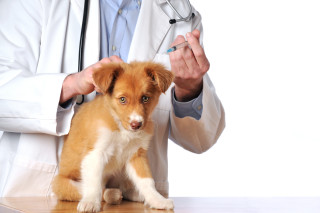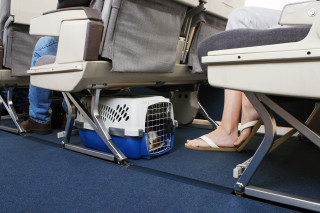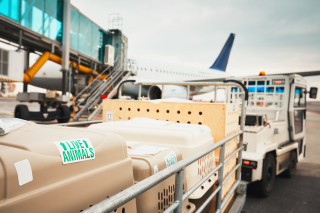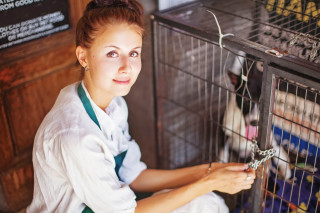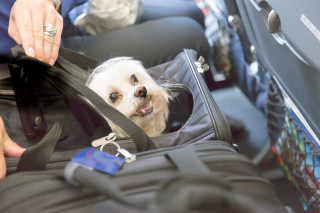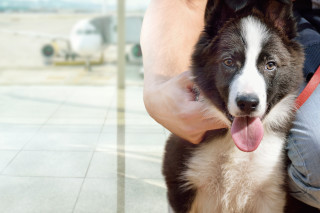Flying with your dog
Many people with dogs probably know the 'problem': what do you do with your dog when you go on vacation? If you can't find a dogsitter, consider taking your dog with you. But how does that work? You can’t just get on a plane with your dog. To summarize: it varies greatly by airline. We have listed a number of practical tips for a successful flight with your four-legged friend.
Frequently asked questions
- From what age can a puppy fly?
- What about health and documents?
- Where should your dog go on the plane?
- Can you bring a guide dog?
- How much does it cost to bring your dog?
- Which dogs are not allowed on the plane?
- What destinations often do not allow dogs?
- What about switching?
- Will you take your dog on the plane?
From what age can a puppy fly?
A newborn puppy is not allowed to fly - but when will it be allowed? It varies by airline: for some companies, puppies are allowed from 8 weeks, and for others only from 3 months old. So be sure to look up the rules of the airline before you book.
What about their health and documents?
Quite logical, but we will mention it anyway. Traveling is already a stressful experience for pets, so make sure they are in good health when you take them on a plane. Sick, old, pregnant or very nervous dogs cannot fly. You wouldn’t want to sit there for hours if you don't feel well, would you?
Just like with people, your dog's passport must also be in order (including travel and health documents). Make sure you make an appointment with the vet well in advance for the necessary treatments or vaccinations because these often have to be administered a minimum number of weeks before departure.
To fly with your pet, they must also be chipped with an electronic identification system (transponder).
Conclusion: booking a last-minute trip with your dog is not recommended :-)
Tip: Avoid sedatives for your pet
Soothing medications for traveling are not recommended unless your vet recommends it for your dog. Besides making your dog drowsy and increasing the risk of air sickness, it does not do much for his/her stress levels. What works better is that you stay calm and talk to him/her in a soothing tone (when you are in the cabin together).
Where can your dog go on the plane?
Another thing you may not know is that there are three different ways to take your dog on a plane:
In the cabin:
Your pet can enter the cabin if it fits in an official travel bag that you place under the seat in front of you. You may not open it during the flight. The maximum allowable weight of your dog and the dimensions of the travel bag vary per airline. With this option, you stay together.
Please note: your dog in the travel bag is often classed as your hand luggage. Check whether you need to book additional hand luggage.
In the luggage compartment:
You fly in the same plane as your dog, but you are not together. Your dog travels in a crate in the luggage compartment, in a specially-heated section that is equipped with climate and pressure control. The crate must meet the legal requirements of the IATA (International Air Transport Association). Ask your pet store for more information if you have any doubts.
Tip: Always attach a copy of your dog's vaccination certificates and health declarations to the crate. This is not mandatory, but it can save a lot of time if there is any lack of clarity.
As cargo:
This increases the chance that you will not travel in the same aircraft. For long flights, it might be a better choice because it is cheaper. For large dogs (> 165 lb), it may be the only option available to be able to go on holiday together with most airlines.
And what about guide dogs?
The regulations are similar for guide dogs, but they are often more relaxed. They are allowed to travel at no extra cost. Contact us by telephone well before departure so that this can be requested.
What does it cost to take your dog?
As stated, the rules and rates are different for each airline.
- In the cabin: between $45 and $170 and the maximum permitted weight of bag + dog varies per airline, but is usually between 10 and 20 lb.
- In the hold: between $45 and $500 - with different rates for traveling in Europe or intercontinental.
Which dogs are often NOT allowed on the plane with you?
So-called 'fighting dogs' or 'attack dogs' that fall within certain categories are not allowed in the cabin or in the cargo hold. The dogs do not have to belong to a certain breed but any that are similar in build to:
- American or English Stafford (Pitbulls) or similar dogs,
- Mastiff (incl. Boerboels) or similar dogs,
- Tosa or similar dogs,
- Rottweilers or similar dogs.
Other airlines go a step further and also have a second category. Check the rules of the airline you want to travel with before you book.
Snub-nosed dogs such as Boston Terriers, Pugs, Bulldogs, Shih-Tzus, Boxers, Chow Chows, Lhasa Apsos, Pekingese, etc. can experience breathing difficulties due to the thin air at high altitudes. This type of dog prefers not to fly.
Which destinations often do not allow dogs?
Unfortunately, you are not allowed to take your pet to some destinations. This has nothing to do with the rules of the country, but with the rules at the airport. This includes the United Kingdom, Ireland, the United Arab Emirates and Chambéry. Check this before you book.
Other islands, including Australia, Hawaii and Ireland also have different rules for traveling with (or entering with) pets. In some cases, animals must be quarantined for some time after arrival to protect the local flora and fauna.
If in doubt, contact the embassy of the country where you want to go. They can inform you of the rules specifically for your dog.
Extra tips for departure
To reduce stress, you can ensure that your dog is already used to the travel crate. Put it out at home and let your dog discover it for themselves, and use it as a lying or sleeping place. After five days, they will be used to it. You might consider using the travel crate to do a few local transport tests, for example, to the grocery store or to a dog park.
You reduce the risk of travel sickness by giving your dog their final meal 8 to 10 hours before departure. Only allow water after that. Also, take a long walk or plan other activities that will cause your dog to burn energy.
Let your dog out as close as possible (2 to 3 hours) to departure. Provide a familiar blanket or toy in the travel crate so that your dog feels more at home.
What about layovers?
If you have a long flight of more than 8 hours, it is recommended to plan a layover. But then there are some additional factors that you have to take into account.
In some cases, you will have to pay extra costs for pet care in between flights. This applies, for example, in Singapore, and at Amsterdam Schiphol; and the costs can amount to $170.
If your layover time permits, then immediately go for a walk with your dog. Most airports nowadays have a "pet relief area" where your dog can attend to its needs.
During a layover, you usually have to pick up your dog and check-in again. This is a good option if the airline allows you to transport your dog to the next plane so that you can be sure that it is on the right plane.
Tip: What if you change planes and airlines?
Check the rules for traveling with animals on both airlines. These can differ from each other and you will have to adhere to both sets of rules.
If your layover lasts longer than 24 hours, then the import rules for pets apply, even if you don't leave the airport. Check this before you book the trip and look into the possible requirements.
Do you want to take your dog on a plane?
Check with the airline directly well in advance (about a month) and before you make your booking. When planning to travel with your pet in the cabin the sizes allowed differs, because your dog must fit in a travel bag under the seat in front of you. We will check with the airline whether it is possible and what it costs and, if you agree, will arrange it for you.
